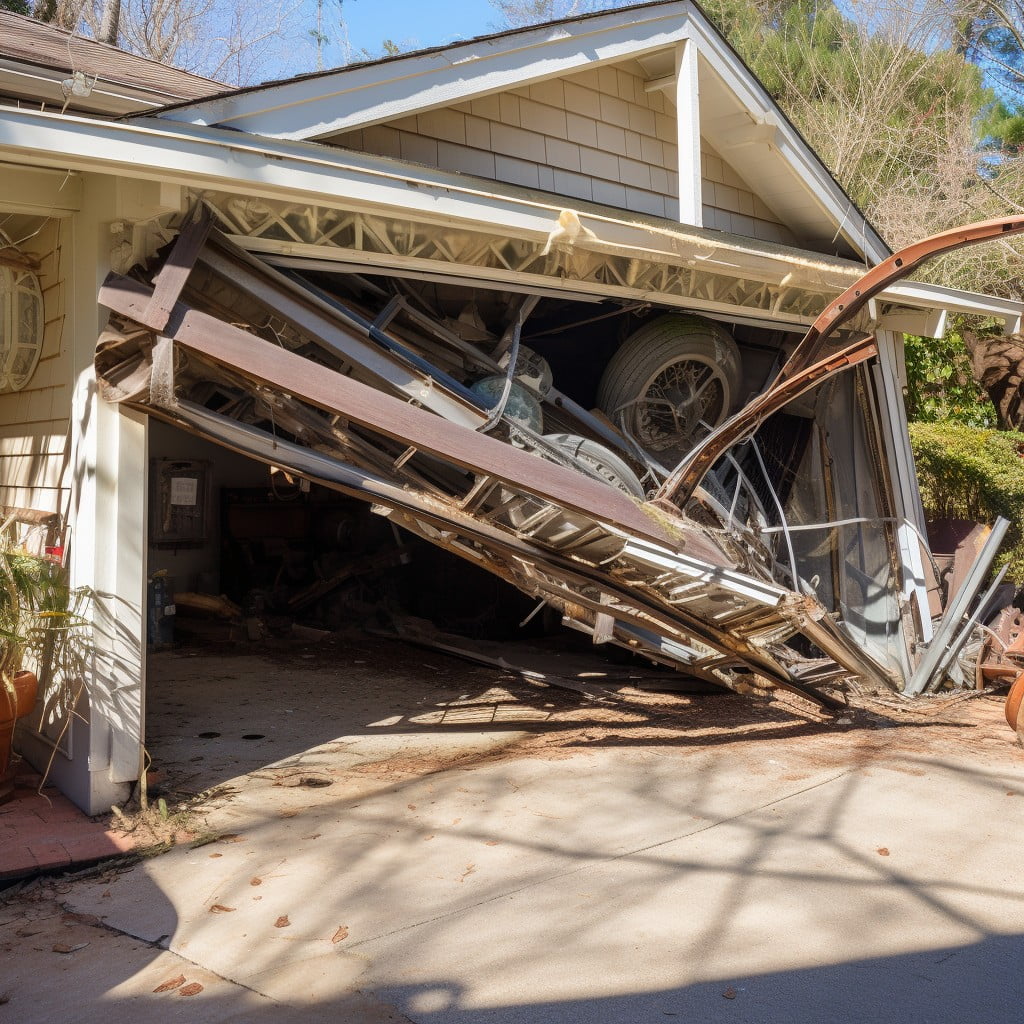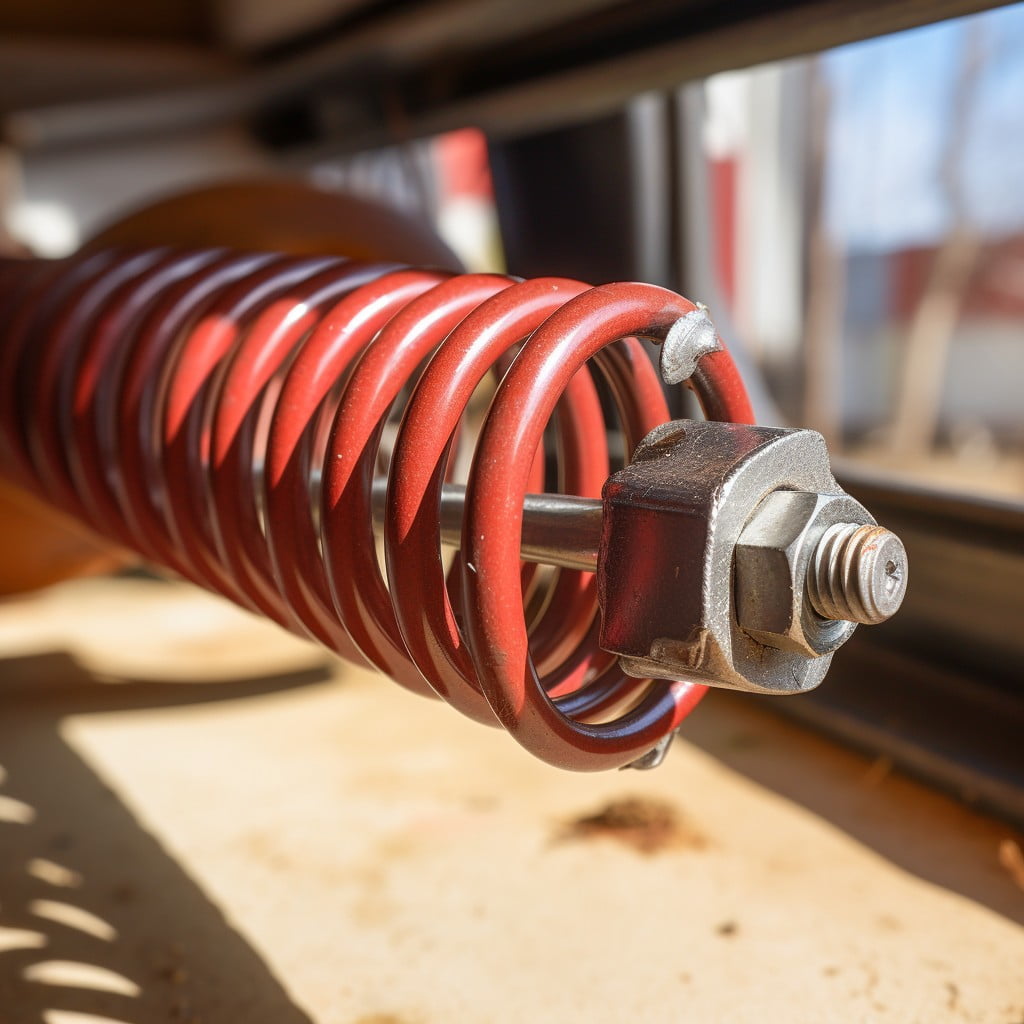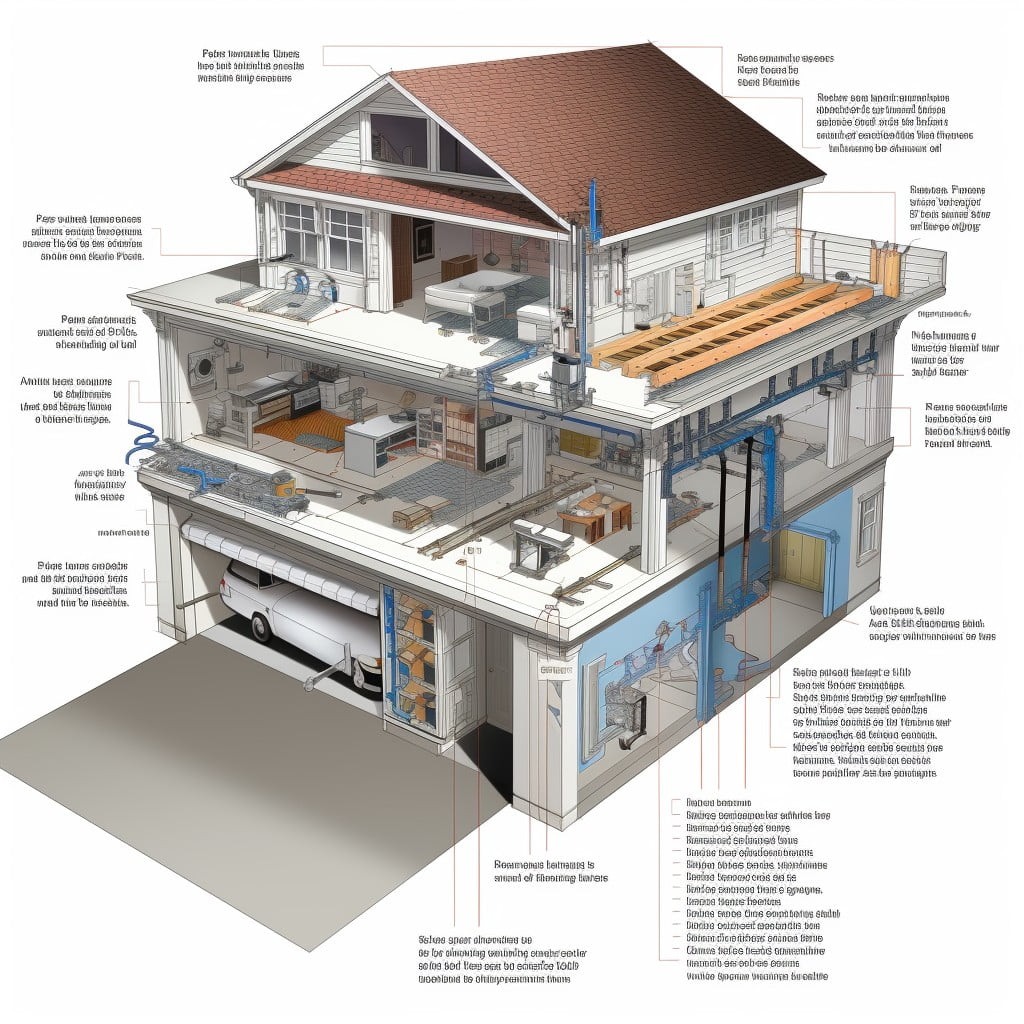Discover the process of safely opening a garage door with a broken spring, ensuring minimal risk and maximum efficiency.
When a garage door spring breaks, it can be quite a hassle. However, it is possible to open your garage door manually. Before you start, ensure you have a partner to help, as garage doors can be heavy and the task can be dangerous.
With the door fully closed, disconnect the garage door opener, and attach vise grips or locking pliers to the track below the bottom roller to keep the door from shooting up. Then, with your partner, lift the door together.
Do remember, this is a temporary solution. A broken spring stores a significant amount of energy and can cause serious injuries if not handled properly. It’s crucial to replace the broken spring as soon as possible.
This article will guide you through the full process, ensuring you know how to safely and effectively open your garage door with a broken spring and how to replace it.
Key takeaways:
- Open garage door with broken spring carefully and with a partner
- Broken spring can cause serious injuries, replace it as soon as possible
- Broken torsion spring: loud noise, door won’t open or feels heavy
- Broken extension spring: door won’t open properly, loud snapping sounds
- Replace both springs even if only one is broken for safety and balance
Understanding What Happens When a Garage Door Spring Breaks

When a garage door spring breaks, the full weight of the door is no longer supported. Essentially, these springs act as a counterbalance system, assisting the door’s motor to move it up and down. As heavy and complex structures, garage doors rely on these springs to help negate their weight, allowing for smooth and easy operation.
Now, bear in mind that springs can either be situated on top of the door (torquemaster or torsion springs) or on the sides (extension springs). Regardless of the type, once damaged, they can no longer carry the door’s weight, making it very challenging to lift.
More so, a common sign of a broken spring is the abrupt, loud noise it produces due to the high tension release. It’s akin to the sound of a firecracker or gunshot. Damage also becomes evident with the door not opening more than a few inches, if at all.
Safety should always be paramount. As a result, it is recommended not to force the door open or closed when the spring is broken, as it can potentially cause further damage to the door or lead to personal injury. Handling broken springs is a job better left to the professionals.
Recognizing Broken Torsion Spring

The torsion spring typically stretches horizontally above the garage door when it is closed, with a stationary cone at one end attached to the spring anchor bracket, and a winding cone at the other end wrapped around the shaft. These helical springs use the method of torsion, or flexing, to balance out the garage door’s weight.
When this vital component breaks, it unwinds and loses its tension, causing it to separate into two pieces. A loud ‘bang’ echoing throughout the garage – much like a firecracker or gunshot – is usually your first indication of a malfunctioning torsion spring, given the large amount of torque it holds.
Even if you missed this auditory announcement, physical cues are present as well. A space or gap of approximately two to four inches will emerge in the torsion spring, visually affirming its failure. Another significant telltale sign is the garage door’s refusal to open fully or its extremely heavy feel when you try to lift it manually. This illustrates the absence of counterbalance forces that a functioning torsion spring typically provides.
Remember, working with a broken torsion spring can be hazardous due to the immense pressure it holds. Professional aid is always recommended to avoid any potential accidents.
Identifying Snapped Extension Spring

Typically found on both sides of the garage door, extension springs function by expanding and contracting with the movement of the door. When these springs are in good condition, they facilitate a smooth up and down motion of the door.
A snapped extension spring is characterized by a variety of signs. The most prominent is when the garage door doesn’t open properly or gets jammed halfway. In some instances, you may also notice that one side of the door is higher than the other.
Another tell-tale sign is loud snapping or popping sounds when the door is in operation. These are caused by the sudden release of tension from a broken spring. Loose or hanging cables can also be indicators of extension spring damage, as these wires lose their tension when the springs break.
Though identifying a damaged extension spring isn’t a herculean task, handling them can be dangerous due to the stored energy. Therefore, it’s advisable to engage professionals when dealing with any faulty spring situation. This will eradicate the risk of accidents or further damage to the garage door system.
Deciphering the Torquemaster System

A unique innovation in the world of garage door systems, the Torquemaster employs a different mechanism as compared to the standard torsion and extension springs. While its interior workings may be complex, a basic understanding of this system will be helpful in identifying issues when they arise.
1. Concealed mechanism: Unlike traditional springs mounted above the garage door, Torquemaster springs are located inside a steel tube. This protective covering helps reduce the impact of a potential spring break, assuring increased safety.
2. Two Type System: The Torquemaster comes in two variants – the Torquemaster One and Torquemaster Plus. The former can only be wound from one end while the latter can be wound from both ends making it easier to adjust the tension.
3. Spring system identification: To identify if your garage utilizes a Torquemaster system, look for a long, round steel rod running across the top of the door. If the system is the Torquemaster Plus, there might also be a winding cone at each end of the rod.
4. Maintenance: Due to its complexity, Torquemaster systems often require professional services for maintenance and repair.
Understanding these key points will aid in the successful operation of your Torquemaster garage door system and assist in timely identification of potential problems.
How to Visually Tell If the Spring Is Broken
Identifying a broken garage door spring visually is not as challenging as one might think. Compromised springs often show clear signs of damage.
1. Gaps: With torsion springs, look for any evident gaps. An intact torsion spring has no spacing whereas a broken one typically has a gap of about 2 inches.
2. Unwound Extension Springs: If the garage has extension springs, check for unwoundness. These appear stretched out when broken.
3. Loose Cables: Broken springs can result in slack cables. If the cables appear to be hanging loosened, the spring might be likely broken.
4. Sudden Halt: If the garage door abruptly stops mid-lift, this could be due to a damaged spring. A quick test is to try lifting the garage door manually.
Remember, safety is paramount. Broken springs can pose a serious hazard hence any suspicion of damage should prompt immediate professional attention.
Will a Garage Door Open With a Broken Spring?
A common concern for homeowners is operating a garage door with a failed spring. While theoretically possible, it’s particularly challenging and poses potential risk. This issue is primarily due to the essential role that springs play in balancing and supporting the door’s weight.
It’s important to clarify that your chances of raising the door greatly depend on the type of spring system installed. For example, if one of two torsion springs breaks, you could still lift the door, but it requires significant effort. However, if a single torsion or extension spring is broken, the door is nearly impossible to open manually due to the loss of support and balance.
Moreover, even if you manage to heave it up, there’s a real danger of the door crashing down without the support from the springs. It’s always recommended to seek professional help when dealing with a broken garage door spring to avoid any potential mishaps or injuries.
Opening A Garage Door With A Broken Torsion Spring
Properly handling a garage door with a broken torsion spring involves the following:
1. Secure Necessary Tools: Gather a couple of C clamps or locking pliers, a sturdy ladder, and a willing assistant for this task.
2. Aid from an Assistant: Position your helper at the other end of the door from where you’re working to balance and control the weight as you lift.
3. Locking Pliers Usage: Make sure your locking pliers are clamped below the bottom roller on both door tracks. This ensures that the door stays put when you lift it.
4. Lifting the Door: Stand on the ladder and, together with your assistant, lift the garage door. It’s needed to be aware that due to the broken torsion spring, the door could be heavy, so proceed with caution to avoid injuries.
5. Lock Door in Open Position: Once the door is lifted to the maximum height, clamp the locking pliers or C clamps on the track right below the bottom roller on both sides to secure the door in position.
Remember, a broken torsion spring creates a hazardous environment due to the heavyweight and heightened pressure associated with garage doors. If you are uncertain about any step in the process, it is highly advised to engage the service of a professional garage door repair technician.
For Doors With 2 Torsion Spring
When dealing with a dual torsion spring setup, the situation can be a bit more complicated. It requires additional caution since the unbroken spring will still carry a considerable amount of tension. If one spring is broken, it’s essential to relieve the tension from the intact spring first to ensure safety.
Here’s how you can approach this situation:
- Disconnect the garage door opener from the electrical outlet.
- Disengage the opener from the door. This is usually achieved by pulling a manual release cord, often red in color.
- With the help of at least one other strong individual, manually lift the door. Keep in mind, the intact spring will bear the brunt of the door’s weight.
- As the door raises, lay a pair of vise grips or locking pliers on the track beneath the bottom roller to keep the door open.
Remember, the unbroken spring, while tasked with supporting even more weight than usual, can also alleviate the door’s weight to some extent. However, it’s crucial to not rely completely on the intact spring to hold the door’s weight as it can fail without indication due to the additional strain.
How to Open a Garage Door With a Broken Extension Spring
Getting a garage door with a broken extension spring open requires careful handling to avoid injuries or further damage. To tackle this safely, follow these instructions:
1. Disconnect the opener: Find the emergency release cord and pull it to disconnect the door from the opener. Typically, the cord is red and hangs from the center rail of your garage door mechanism.
2. Secure the door: Once the opener is disconnected, secure the door using C-clamps or locking pliers on the vertical track just below the bottom roller. This will prevent the door from crashing down once it’s lifted.
3. Lift the door: Standing at one side of the door, gently and gradually lift it. Extension springs store immense energy—proceed with caution.
4. Prop the door open: Utilize sawhorses or similar sturdy items to prop up the door, making sure they’re the same height as the open door. Never use items that may slide or roll.
5. Seek professional help: Unless you’re a proven DIY professional with experience in garage doors, consider seeking assistance from a professional to replace the broken spring. Missteps can be dangerous, given the high-tension nature of these components.
Always remember, safety is paramount. Broken extension springs can be hazardous to handle, and it’s recommended to let professionals do their job.
Should You Replace Both Springs If Only One Is Broken?
In an ideal scenario, both springs should be replaced even if only one is broken. Here’s why:
1. Life Span: Garage door springs, whether torsion or extension, are designed to last a specific number of cycles. A cycle is one complete opening and closing of the garage door. If one spring has broken, it’s highly likely the other spring is also near its life end.
2. Balanced Operation: Springs work together to lift and lower the door evenly. A new spring paired with an old one can cause imbalance, reducing the functionality of your garage door system and potentially causing more damage.
3. Preventive Maintenance: Replacing both springs at the same time can also act as preemptive maintenance. This way, you avoid the inconvenience of another potential break and the additional cost of another service call.
4. Cost-Effectiveness: Most professionals will charge less to replace two springs at once than they would charge to replace each one individually. This can save you money in the long run.
5. Safety Considerations: A garage door with one new and one old spring can present a safety hazard. In case the older spring breaks, it can damage your garage or even cause injury.
Thus, replacing both springs simultaneously can offer peace of mind knowing that your garage door system is safe, balanced, and less likely to break down in the near future.
Replacing or Repairing Garage Door Springs: Factors to Consider
When considering either replacement or repair of a garage door spring, it’s prudent to evaluate a few key aspects.
Firstly, gauge the current condition of the entire door system. Is the door old or heavily-used? Do the other parts appear worn out? If so, replacing the entire assembly might offer a long-term solution. This way, you avoid successive repairs which can add up to the same or even more than a full replacement.
Secondly, evaluate the severity of the spring’s damage. Consult with a garage door repair professional, as they can best diagnose whether a spring can be safely repaired or needs replacement. Some broken springs might be fixable, yet others might necessitate replacement for optimum safety and performance.
Lastly, consider the cost implications. Look at both immediate and long-term costs of both repair and replacement. While repairing might seem cost-efficient now, if the spring is nearing its lifespan end, recurrent repairs could surpass replacement cost. Thus, opting for the initially expensive replacement may be economical in the long run.
Remember, never attempt to fix a garage door spring by yourself unless you have relevant experience. Improper handling can lead to personal injury or further door damage. Always consult a professional.
Projected Cost of Garage Door Spring Replacement
There are a myriad of factors that contribute to the cost of replacing a garage door spring. Primarily, the type and size of spring utilized in your garage door system can significantly affect the price. For instance, torsion springs, being more durable and heavy-duty, tend to cost more than extension springs.
Now, taking into consideration the price of the spring itself, one should also factor in labor costs. Whereas some homeowners may feel comfortable trying to undertake this task themselves, hiring a garage door professional is generally recommended. Their expertise can ensure that the replacement is completed correctly, efficiently, and most importantly, safely. Professional services typically range from $100-$200, depending on your geographic location.
Lastly, when calculating the cost, remember the adage – “Buy cheap, buy twice”. Prioritizing quality over cost can save you further repairs in the long run. Top-notch springs can cost from $20-$30 for extension springs and $40-$100 for torsion springs. Overall, you could anticipate a total cost ranging from $120-$300 for the replacement of a garage door spring. Always remember, investing in your garage door’s health is investing in your home’s functionality and safety.
FAQ
Can you open a garage door manually with a broken spring?
Yes, a garage door with a broken spring can be opened manually, but it requires considerable effort and may potentially damage the garage door opener due to the increased weight.
Can garage door work with one spring?
Yes, a garage door can work with one spring, especially if it's a smaller, one-car steel garage door that is less than 10' wide by 7' tall.
What are the risks involved in attempting to open a garage door with a broken spring?
Attempting to open a garage door with a broken spring poses serious risks including potential physical harm due to the sudden release of tension and possible damage to the door or nearby property.
How can one identify signs of a deteriorating garage door spring before it breaks?
Signs of a deteriorating garage door spring can be identified by irregular door movement, an unusually heavy door, a visibly stretched spring, or a garage door that doesn't stay up when lifted half-way.
Are there any temporary fixes available for a broken garage door spring?
While a temporary fix such as using a C-clamp on the door track for stability is possible, a broken garage door spring requires professional repair due to the inherent danger and complexity of the task.